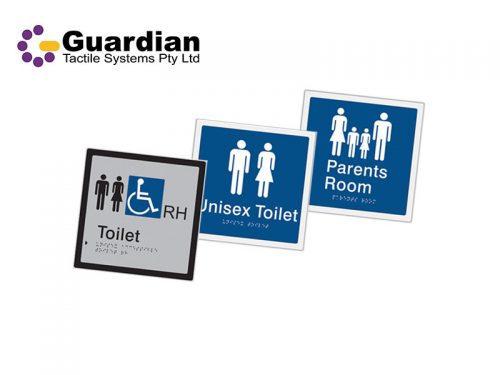Guidelines for Raised Tactile and Braille Signage
Use Building Code Specification D3.6 for manufacturing and installation guidelines with the following qualifications:
-
- Signs with single lines of characters must have the line of tactile characters not less than 1450mm and not higher than 1550mm above the floor or ground surface.
- All room signage must be positioned as described in 2.1( c) of Specification D3.6
- Sentence Case must be used for all Raised Tactile Text.
- Where graphics are used on a sign, text must also be used.
- A border around a sign is not required unless the sign background and the colour surface it is being mounted on or against do not achieve a minimum 30% luminance contrast.
- Where the text on the sign is not descriptive of the entire sign, the Braille must describe the entire message being conveyed by the sign.
- It is more important to locate the Raised Tactile components of the sign between 1200mm and 1600mm above the ground or floor level. On some signs the amount of Raised Tactile information may make it difficult to locate the Braille 8mm below the Text. When this occurs the Braille can be provided as a separate block between 1000mm and 1200mm above the ground or floor level. A Raised Semi Circular Braille locator must be used on the left margin horizontally aligned with the first line of Braille text.
- Braille arrows must be a solid block, the same dimensions as a Braille cell, not a series of dots. Braille arrows must be used wherever Raised Tactile Arrows are used in the text section of the sign.
- Luminance contrast rules apply to every adjoining colour and surface in a Raised Tactile and Braille Map.
- Where used, Raised Tactile and Braille Maps must be located along the path of travel, within 2 meters of either the principal entry point to the property or the principal public entrance to the building and in other locations deemed appropriate by an accredited access consultant. These must be positioned within 1 meter of the continuous accessible path of travel on the left hand side as you approach the entry point. If this is not possible, locating on the right hand side is acceptable. The use of Tactile Ground Surface Indicators to assist in the location of Raised Tactile and Braille Maps must be considered.
- Raised Tactile and Braille Maps must be positioned between 1000mm and 1700mm above the ground or floor level and be mounted on an angle of no more than 30 from vertical to allow comfortable reading by touch.
- The minimum Sentence Case height for Raised Tactile and Braille Maps is 12mm.
- The minimum icon/graphic height of Raised Tactile pictograms on maps is 12mm.
- Each icon/graphic must be clearly definable from each other by touch.
- All the Raised Tactile information on the Map component must be described in a legend.
- The map component can be Raised Tactile only, however all information in the legend must include an explanation in Braille.
- Each separate Raised Element in a Raised Tactile Map must be unique either is shape, size, texture or colour, or a combination of any of these.
- The You are Here locator on a Raised Tactile Map must be the highest point on the map.
- Raised Tactile and Braille Maps must include the following information:
- the locations of all toilet facilities
- the locations of all information points, which may include other Raised Tactile and Braille maps and Raised Tactile and Braille directional signs
- the locations of all entry and exit points including emergency evacuation exits
- the locations of all lifts, escalators, travelators, ramps and stairs on the continuous accessible path of travel
- the locations of the principal tenants of the buildings and/or the location of directory boards which identify the locations of the principal tenants
- the locations of taxi, bus stops, and other public transport pickup/set down points within the boundaries of the property
- the locations of other major features which are important to the safety or amenity of a person who is Blind or has a Vision Impairment, such as postal, telephone, and assistance points
- the paths of travel from the property boundary, into and through the building and adjoining buildings where these are within the same property boundary
(Note: where campuses or large buildings are being mapped it may be necessary to have a number of different maps with connections shown to each)
- Other information on a Raised Tactile and Braille Map may be provided in a visual subsurface form only.
- As with Raised Tactile and Braille Signage the surface of a Raised Tactile and Braille Map must be continuous and must resist removal through use, abuse, fair wear and tear.
- Each layer of the map must be consistent and built from the base up eg.,
- Layer 1 = Buildings, Parks etc
- Layer 2 = Roadways, pathways, paths of travel, features and facilities
- Layer 3 = You are here
- The design of Raised Tactile and Braille Maps must be kept as simple as possible without omitting necessary detail.
